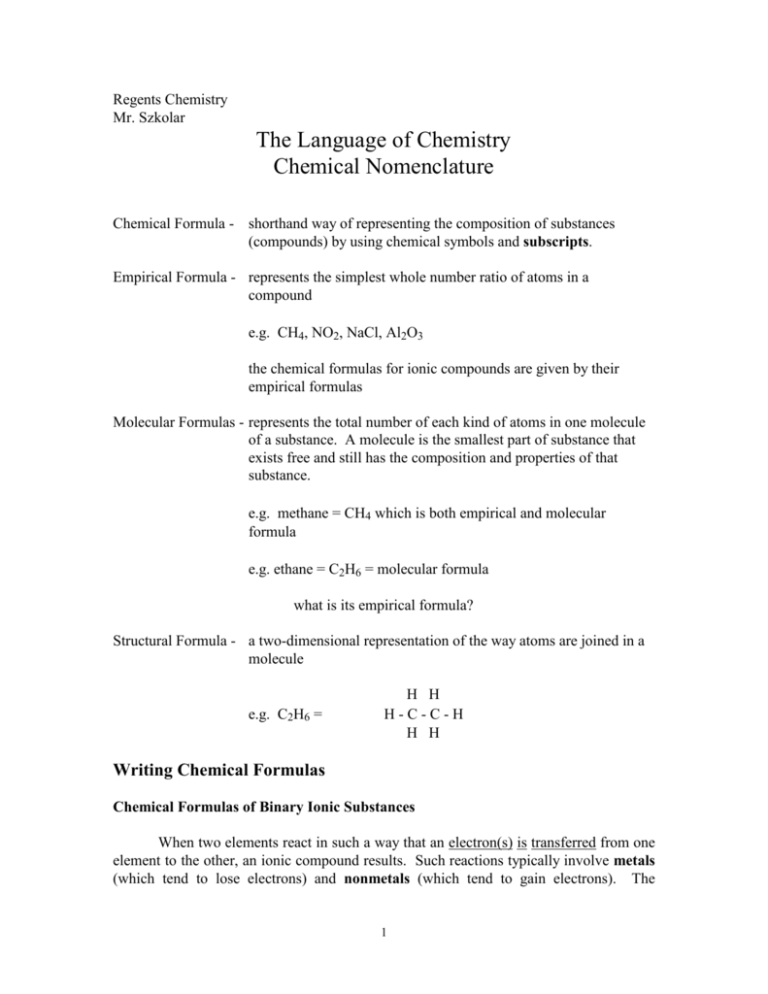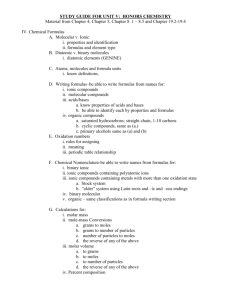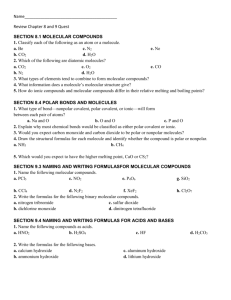Writing Chemical Formulas
advertisement

Regents Chemistry
Mr. Szkolar
The Language of Chemistry
Chemical Nomenclature
Chemical Formula - shorthand way of representing the composition of substances
(compounds) by using chemical symbols and subscripts.
Empirical Formula - represents the simplest whole number ratio of atoms in a
compound
e.g. CH4, NO2, NaCl, Al2O3
the chemical formulas for ionic compounds are given by their
empirical formulas
Molecular Formulas - represents the total number of each kind of atoms in one molecule
of a substance. A molecule is the smallest part of substance that
exists free and still has the composition and properties of that
substance.
e.g. methane = CH4 which is both empirical and molecular
formula
e.g. ethane = C2H6 = molecular formula
what is its empirical formula?
Structural Formula - a two-dimensional representation of the way atoms are joined in a
molecule
e.g. C2H6 =
H H
H-C-C-H
H H
Writing Chemical Formulas
Chemical Formulas of Binary Ionic Substances
When two elements react in such a way that an electron(s) is transferred from one
element to the other, an ionic compound results. Such reactions typically involve metals
(which tend to lose electrons) and nonmetals (which tend to gain electrons). The
1
resulting electrically charged atoms, called ions, exhibit very strong electrostatic forces of
attraction between the positive metal ion (cation) and the negative nonmetal ion (anion).
This attraction results in an ionic bond.
e.g.
protons
electrons
net charge
Li +
metal
3+
30
F
nonmetal
9+
90
LiF
3+9+
2-10+1 -1 = 0
In writing the chemical formulas for any neutral ionic compound, subscripts are
adjusted so the sum of the charge of the different atoms adds up to zero (charge
conservation). In order to determine the charge on an atom we need to know its oxidation
number. The oxidation numbers of elements reflect how atoms gain, lose, or share
electrons when forming chemical bonds with other atoms. The atom with the positive
oxidation number is customarily written first.
The oxidation numbers for elements within the following groups is summarized:
Group 1 = +1
2 = +2
13 = +3
15 = -3 for N and -3 for P
16 = -2
17 = -1
Common Simple Cations and Anions
Cation
Name
Anion
Name*
H+
Li+
Na+
K+
Cs+
Be2+
Mg2+
Ca2+
Ba2+
Al3+
Ag+
hydrogen
lithium
sodium
potassium
cesium
beryllium
magnesium
calcium
barium
aluminum
silver
HFClBrIO2S2Se2N3P3-
hydride
fluoride
chloride
bromide
iodide
oxide
sulfide
selenide
nitride
phosphide
*the root is given in bold.
2
We will first consider binary ionic compounds in which the metal ion (cation) can have
only one possible oxidation number. Your textbook refers to these as Type I compounds.
In naming these compounds, the name of the metal is unchanged while the nonmetal
takes an “ide” suffix. If you are given the name, in writing the formula we must keep in
mind the idea of conservation of charge. This means the total positive charge must equal
the total negative charge on a neutral compound. Adjusting the subscripts of the cation
and anion does this. Use the “criss-cross” method to write these formulas. Let’s try some
problems.
write the chemical formula for
magnesium bromide:
aluminum selenide:
calcium nitride:
sodium sulfide:
Give the names of the following compounds:
LiF:
AlBr3:
SrO:
Mg3N2:
The metals found in groups 3-12, called transition metals, may have multiple oxidation
numbers. In this case, we must specify the oxidation number of the cation by using a
roman numeral. Your textbook designates ionic compounds containing these metals as
Type II compounds. Your Periodic Table lists the possible oxidation numbers for all
elements (upper right hand corner). Using the roman numeral in a name is called the
“stock” name. For certain cations, we will also use traditional names. The old or
traditional system of designating oxidation numbers (for those metals having only two
3
oxidation numbers) is by using the suffix “ous” for the lower oxidation number and the
suffix “ic” for the higher one. You will be responsible for memorizing the following
cations with their charges, stock designations, and traditional names:
Symbol
Name
Cation
Traditional
Stock
Co
cobalt
Co2+
Co3+
cobaltous
cobaltic
cobalt(II)
cobalt(III)
Cu
copper
Cu+
Cu2+
cuprous
cupric
copper(I)
copper(II)
Fe
iron
Fe2+
Fe3+
ferrous
ferric
iron(II)
iron(III)
Hg
dimercury
mercury
Hg22+
Hg2+
mercurous
mercuric
mercury(I)
mercury(II)
Pb
lead
Pb2+
Pb4+
plumbous
plumbic
lead(II)
lead(IV)
Sn
tin
Sn2+
Sn4+
stannous
stannic
tin(II)
tin(IV)
Write chemical formulas for the following compounds:
Iron(II)chloride:
Iron(III)chloride:
Plumbic oxide:
Cuprous bromide:
Mercuric fluoride:
Mercurous fluoride:
4
Name the following compounds:
compound
stock
traditional
SnO
SnO2
PbI2
CuO
Hg2F2
Formulas for Binary Compounds Containing Only Nonmetals (Molecular
Compounds)
Molecular compounds result from the sharing of electrons between two
nonmetals. The sharing of electrons results in a covalent bond. Your textbook refers to
these as Type III compounds. In the traditional naming of molecular compounds prefixes
are used to designate the number of atoms of each element in the compound.
1
2
3
4
5
6
7
8
9
10
mono
di
tri
tetra
penta
hexa
hepta
octa
nona
deca
The elements in a molecular compound may not share electrons equally. The
element with the stronger attraction for electrons are said to be more electronegative and
acquire a partial negative charge. In naming these molecular compounds, the less
electronegative element (carrying a partial positive charge) is named first, and the name
of the second element takes the suffix “ide”. We need not be concerned with determining
the electroegativities at this point. We use oxidation numbers in writing formulas for
molecular compounds using the stock system. In this case the second (or negative)
element of the compound dictates the oxidation number of the first (positive) element.
Let’s try some examples.
Name the following compounds using traditional and stock systems.
5
traditional
stock
SO3
CO2
N2O5
PCl3
Write the formulas of these compounds given their names:
nitrogen trifluoride:
carbon(II)oxide:
dihydrogen monoxide:
sulfur(VI)chloride:
Chemical Formulas for Compounds Containing Molecular (Polyatomic) Ions
Here the same rules apply as for binary ionic compounds only the name of the
molecular ion is unchanged. Keep in mind that you balance the charge of the whole
molecular ion (treat it as one unit). If you need to balance the charge by adjusting the
subscript of a molecular ion, then enclose it in parenthesis with the subscript outside the
parenthesis. You will need to memorize the formulas and charges of the common
polyatomic ions given in Table 4.4 of your text and reproduced below:
6
Ion
Name
Ion
Name
NH4+
ammonium
MnO4-
permanganate
C2H3O2-
acetate
NO2-
nitrite
CN-
cyanide
NO3-
nitrate
CO32-
carbonate
O22-
peroxide
HCO3-
hydrogen carbonate (bicarbonate)
OH-
hydroxide
C2O42-
oxalate
PO43-
phosphate
H3O+
hydronium
HPO42-
hydrogen phosphate
ClO-
hypochlorite
H2PO4-
dihydrogen phosphate
ClO2-
chlorite
SCN-
thiocyanate
ClO3-
chlorate
SO32-
sulfite
ClO4-
perchlorate
SO42-
sulfate
CrO42-
chromate
HSO4-
hydrogen sulfate
Cr2O72-
dichromate
S2O32-
thiosulfate
Write the chemical formulas for the following compounds:
sodium chlorate:
potassium chromate:
magnesium acetate:
ferrous sulfate:
7
ammonium oxalate:
calcium hydroxide:
Give the stock and traditional (where applicable) names:
CuCO3:
Sn(NO3)4:
AlPO4:
Al2(SO4)3:
Naming Acids
An acid is any substance containing hydrogen as a positive ion that splits up
(ionizes) to H+ and a negative ion when dissolved in water:
HX(s) H+(aq) + X-(aq)
The (aq) designation for phase is “aqueous”, which means dissolved in water. In naming
binary acids (acids composed of two elements only, one of which must be H), we use the
prefix “hydro”, followed by the stem of the anion, and followed by the suffix “ic” and the
word acid. This will be the case if the anion does not contain oxygen.
e.g.
HCl:
HF:
H2S:
HBr:
Ternary acids contain a molecular ion containing oxygen (an oxyanion). If the
oxyanion ends in “ate”, the acid takes a suffix “ic”. If the oxyanion ends in “ite”{, the
acid takes the suffix “ous”.
8
e.g.
oxyanion
acid
oxyanion
acid
“ate”
“ic”
“ite”
“ous”
HNO2
HNO3
H3PO4
H2SO4
Give the chemical formulas for the following acids:
phosphorous acid:
chloric acid:
sulfurous acid:
acetic acid:
In some cases, typically with the chlorate ion, the prefixes “hypo” (meaning one
less oxygen) and “per” (meaning one more oxygen) can be used.
Anion
Formula
Acid Formula
chlorate
chlorite
hypochlorite
perchlorate
9
Acid Name




